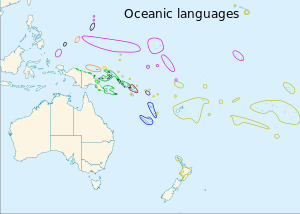The Micronesians or Micronesian peoples are various closely related ethnic groups native to Micronesia, a region of Oceania in the Pacific Ocean. They are a part of the Austronesian ethnolinguistic group, which has an Urheimat in Taiwan.

The Philippine languages or Philippinic are a proposed group by R. David Paul Zorc (1986) and Robert Blust that include all the languages of the Philippines and northern Sulawesi, Indonesia—except Sama–Bajaw and a few languages of Palawan—and form a subfamily of Austronesian languages. Although the Philippines is near the center of Austronesian expansion from Formosa, there is little linguistic diversity among the approximately 150 Philippine languages, suggesting that earlier diversity has been erased by the spread of the ancestor of the modern Philippine languages.

The approximately 450 Oceanic languages are a branch of the Austronesian languages. The area occupied by speakers of these languages includes Polynesia, as well as much of Melanesia and Micronesia. Though covering a vast area, Oceanic languages are spoken by only two million people. The largest individual Oceanic languages are Eastern Fijian with over 600,000 speakers, and Samoan with an estimated 400,000 speakers. The Gilbertese (Kiribati), Tongan, Tahitian, Māori and Tolai languages each have over 100,000 speakers. The common ancestor which is reconstructed for this group of languages is called Proto-Oceanic.
The Mussau-Emira language is spoken on the islands of Mussau and Emirau in the St Matthias Islands in the Bismarck Archipelago.

Chuukic, historically also rendered as Trukic, is a subgroup of the Chuukic–Pohnpeic family of the Austronesian language family. The languages are primarily spoken in Chuuk State and Yap State of the Federated States of Micronesia, as well as in the outer islands of Palau. The Carolinians of the Commonwealth of the Northern Mariana Islands also speak their own language distinct from the historically native Chamorro people.

Pohnpeic, also rendered Ponapeic, is a subgroup of the Chuukic–Pohnpeic branch of Micronesian in the Austronesian language family. The languages are primarily spoken in Pohnpei State of the Federated States of Micronesia.
The Huon Gulf languages are Western Oceanic languages spoken primarily in Morobe Province of Papua New Guinea. They may form a group of the North New Guinea languages, perhaps within the Ngero–Vitiaz branch of that family.

Kosraean is the language spoken on the islands of Kosrae (Kusaie), a nation-state of the Federated States of Micronesia, Caroline Islands. In 2001 there were approximately 8,000 speakers in Micronesia, and 9,060 in all countries.
The Pingelapese language is a Micronesian language native to Pingelap, an atoll belonging to the state of Pohnpei in the Federated States of Micronesia. This atoll is the homeland to the Pingelapese people, consisting of a three-square mile range of uninhabited small coral islets, Daekae and Sukora, and the inhabited islet, Pingelap. These islands partially make up the Caroline Islands.
Iaai is a language of Ouvéa Island. It shares the island of Ouvéa with Fagauvea, a Polynesian outlier language.
Proto-Oceanic is a proto-language that historical linguists since Otto Dempwolff have reconstructed as the hypothetical common ancestor of the Oceanic subgroup of the Austronesian language family. Proto-Oceanic is a descendant of the Proto-Austronesian language (PAN), the common ancestor of the Austronesian languages.
The Muna–Buton languages are a group of languages spoken on the islands of Muna and Buton off the coast of South East Sulawesi province, Indonesia. They belong to the Celebic subgroup of the Austronesian family.
The Saluan–Banggai languages are a group of closely related languages spoken in eastern Central Sulawesi province, Indonesia. They belong to the Celebic subgroup of the Austronesian family.
The Wotu–Wolio languages are a group of closely related languages spoken in Sulawesi that belong to the Celebic subgroup of the Austronesian family.
Selaru is an Austronesian language of Selaru and Yamdena, in the Maluku Islands of Indonesia. Linguistically it is not close to Seluwasan, its nearest relative.
Nuguria (Nukuria) was a Polynesian language, spoken by approximately 550 people on Nuguria in the eastern islands of Papua New Guinea. The language was taught in primary schools in Nuguria and was used for daily communications between adults and children. Nuguria is one of the eighteen small islands to the east of Papua New Guinea, which are known as the Polynesian Outliers. The Nukuria language has been concluded to be closely related to other nearby languages such as Nukumanu, Takuu, Nukuoro, and Luangiua. Research on the Nuguria Atoll and the language itself is scarce; past research demonstrated that this language was at risk of potential endangerment. The language was only then classified as at risk of endangerment because it was still used between generations and was passed on to the children. However, recent research indicates that Nukuria is now most likely an extinct language.
Lenakel, or West Tanna, is a dialect chain spoken on the western coast of Tanna Island in Vanuatu.
Darrell T. Tryon was a New Zealand-born linguist, academic, and specialist in Austronesian languages. Specifically, Tryon specialised in the study of the languages of the Pacific Islands, particularly Vanuatu, the Solomon Islands, and the French-speaking Pacific.
Proto-Temotu is the reconstructed ancestor of the Temotu languages of Temotu Province, Solomon Islands. It belongs to the Oceanic branch of the Austronesian languages.
Proto-Micronesian is the reconstructed ancestor of the Micronesian languages. It belongs to the Oceanic branch of the Austronesian languages.




